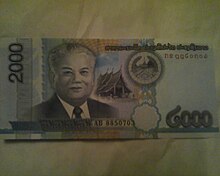Kaysone Phomvihane: Difference between revisions
ClueBot NG (talk | contribs) m Reverting possible vandalism by 24.76.22.103 to version by Helpful Pixie Bot. False positive? Report it. Thanks, ClueBot NG. (980662) (Bot) |
No edit summary |
||
| Line 15: | Line 15: | ||
He died in [[Vientiane]]. After his death, the Laotian government built an eight million dollar gold-plated museum in his honor, in Vientiane, partially funded by Vietnam.<ref name=museum>{{cite web |url=http://www.culturalprofiles.net/laos/Units/163.html |title=Former President Kaysone Phomvihane Memorial Museum |accessdate=2007-09-10 |work=Visiting Arts, Laos Cultural Profile}}</ref> |
He died in [[Vientiane]]. After his death, the Laotian government built an eight million dollar gold-plated museum in his honor, in Vientiane, partially funded by Vietnam.<ref name=museum>{{cite web |url=http://www.culturalprofiles.net/laos/Units/163.html |title=Former President Kaysone Phomvihane Memorial Museum |accessdate=2007-09-10 |work=Visiting Arts, Laos Cultural Profile}}</ref> |
||
[[File:Lao kip 2000.jpg|thumb|Kaysone Phomvihane on the new 2000 kip]] |
|||
==References== |
==References== |
||
{{reflist}} |
{{reflist}} |
||
Revision as of 01:44, 11 May 2012
Kaysone Phomvihane (ໄກສອນ ພົມວິຫານ) (December 13, 1920 – November 21, 1992) was the leader of the Lao People's Revolutionary Party from 1955, though Souphanouvong served in a figurehead role. He served as the first Prime Minister of the Lao People's Democratic Republic from 1975 to 1991 and then as President from 1991 until his death in 1992.
Biography
Phomvihane was born Nguyen Cai Song[1] to a Vietnamese father named Nguyen Tri Loan, and a Laotian mother named Nang Dok. He had two sisters: Nang Souvanthong, living in Thailand, and Nang Kongmany in the USA.[2] He was born in Na Seng village, Khanthabouli district (now Kaysone Phomvihane District, Savannakhet Province), Laos. He had one brother and one sister.
Phomvihane attended law school at Hanoi University in Hanoi, Vietnam. He dropped out of law school to fight the French colonialists who were in Vietnam. Later, he joined the Pathet Lao, which was also fighting the French colonialists.
He became an active revolutionary while studying in the Indochinese capital of Hanoi during the 1940s. In 1955 he was instrumental in setting up the LPRP at Sam Neua in northern Laos, and subsequently served as the Pathet Lao leader, although Souphanouvong served as the figurehead. In the years which followed he led communist forces against the Kingdom of Laos and the Americans. After their victory he served as Prime Minister from the founding of the Lao PDR in 1975 until 1991. He married Thongvinh Phomvihane.
Phomvihane displayed expert skills in handling relations with Vietnam. The demarcation process started in 1977 and just finished in 2007. According to western journalist the Lao/Viet borderline is "very close" to the 1945 border between Laos and Tonkin and Annam, respectively.
According to Vatthana Pholsena, assistant professor of Southeast Asian Studies at the National University of Singapore and author of the book "Post-war Laos", Kaysone Phomvihane was the top policy maker in LPDR, and a strongman. He created Sekong province to honor the southern minority for their support on the war effort.
He died in Vientiane. After his death, the Laotian government built an eight million dollar gold-plated museum in his honor, in Vientiane, partially funded by Vietnam.[3]

References
- ^ Asia & Pacific Review Published by World of Information, 1994, ISBN 0-7494-1069-8, pg 117
- ^ Arthur J. Dommen, The Indochinese Experience of the French and the Americans: Nationalism and Communism in Cambodia, Laos, and Vietnam, Indiana University Press, 2001, ISBN 0-253-33854-9, pg 181
- ^ "Former President Kaysone Phomvihane Memorial Museum". Visiting Arts, Laos Cultural Profile. Retrieved 2007-09-10.


